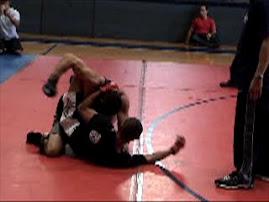
FIGHTING FOR THE RIGHT TO FIGHT:
PART II -- COVERT GENDER DISPARITIES
[Cross-posted on FightTicker.com]
With Christiane Santos and Gina Carano headlining a major mixed martial arts (MMA) card, this 3-part series examines the state of women in MMA. Part I of this series overviews the progress women have made in MMA.
This piece outlines some of the more subtle setbacks women still face as they integrate into this male-dominated sport. It should be clarified that the sporting world is male-dominated. Even sporting organizations like the WNBA are bankrolled by the NBA, which has no gendered marker (i.e., MNBA). Furthermore, criticism made in this piece in no way suggests a distain for women's progression through the sport, but rather points out, we've got a long way to go to reach gender equity.
Women's Representation is Minimal Throughout the MMA Industry
When discussing the paucity of women in MMA relative to men, people are frequently referring to athletes. In fact, Dana White has expressed a reluctance to bring women into the UFC or WEC because it would be difficult to establish a full division of female fighters. In the weight classes ranging from 125 to 145, it is possible to create a robust women's division. However, doing so would probably require recruiting female fighters long-term from Japan, which could be difficult.
 Megumi Fujii may be the best pound-for-pound mixed martial artist (male or female). But if offered, would she really sign a long-term deal with the UFC or WEC?
Megumi Fujii may be the best pound-for-pound mixed martial artist (male or female). But if offered, would she really sign a long-term deal with the UFC or WEC?But in addition to fighters, as in other sporting industries, women in MMA are grossly under-represented as coaches, managers, promoters, referees and reporters. Many female mixed martial artists also coach. This notwithstanding, the number of coaches in MMA gyms is still overwhelmingly male. Moving up the ranks in the MMA industry, the gendered disproportionality becomes even more skewed. The number of female MMA managers and referees is very small, though Kim Winslow has made a breakthrough as an official. Among MMA promoters, Diana Ocampo is one of only a handful who is female in North America and perhaps the world.
And then there is the media. Quickly browsing around the various MMA news and blog sites, one can see that the vast majority of writers (and probably commenters) is male. Maggie Hendricks of Yahoo! Sports and Loretta Hunt of Sherdog.com are two prominent female MMA journalists. And FightTicker.com may be the only MMA website with a Youth Contributor -- Samantha Roberts (MMABrat), who happens to be female. As will be detailed in Part III, discrimination enacted upon female sports journalists is still far too common in MMA and sports as a whole. The lack of women in sports and MMA media limits our perspective on how sport affects society, as males simply hear one another's points of view.
Emphasized Femininity
With women being under-represented in sport and simply having fewer opportunities to earn income through sport (female mixed martial artists frequently earn less than their male counterparts), those women who can emphasize their sexuality for profit sometimes do. Male athletes do this as well, but not nearly as often, and the media tends not to promote male athletes' sexuality as much as it does women's.
Despite being a fantastic athlete, Gina Carano's popularity is fueled heavily by her aesthetic appeal. Undoubtedly, she, MMA promoters, and various media entities have capitalized off this. Carano has appeared in the magazine, Maxim, which caters to heterosexual men, and a handful of other female MMA athletes engage in similar promotional practices. Of course, spotlighting female athletes' sexuality over their athleticism has been a long-standing media practice. Danica Patrick (auto racing) and Maria Sharapova (tennis) are two of the more recent female sports stars to have an emphasized femininity presented in magazines, though there are many more.

 Danica Patrick (top), posing for Sports Illustrated, and Gina Carano, posing for Maxim. Sexuality has always been made a bigger factor in women’s sports than in men's.
Danica Patrick (top), posing for Sports Illustrated, and Gina Carano, posing for Maxim. Sexuality has always been made a bigger factor in women’s sports than in men's.The Said Threat to Traditional Femininity
Building off the above point, Strikeforce's main event match between Carano and Santos is reminiscent of the greatest female sports rivalry of all time in its promotional tactics. The card is titled "Carano vs. Cyborg," rather than "Carano vs. Santos" or "Conviction vs. Cyborg," pointing to the opposing ways these two women are being characterized. Carano is painted as the acceptably feminine athlete, as "Mixed Martial Arts' (MMA) leading lady,” who is “armed with both skill and beauty,” thereby supporting conventional gender norms. On the other hand, the more muscular Santos has her nickname, "Cyborg," inserted into the card's title, distinguishing her as the female threat to Carano, and in turn a threat to acceptable femininity.
The promotional tactics of "Carano vs. Cyborg" mimic the long-standing, eventually friendly tennis rivalry between Martina Navratilova and Chris Evert from the 1970s. Navratilova's femininity was always questioned, even ridiculed by the media due to her foreign status and sexuality. Evert was conversely presented as the mainstay for proper womanhood. As the two women dueled it out on the tennis court, they came to represent these diverging perspectives on femininity.
 Martina Navratilova and Chris Evert shared a classic rivalry and still share a friendship, but their femininity was portrayed by the media in oppositional fashion.
Martina Navratilova and Chris Evert shared a classic rivalry and still share a friendship, but their femininity was portrayed by the media in oppositional fashion.Although the two tennis stars were the same size, Navratilova's musculature was frequently highlighted in pictures -- an alleged threat to the more traditionally feminine and American smile of Evert caught on camera. According to FightTicker's Mark Figula, Santos is well aware of how her match with Carano is being played out in similar style, saying, "I know people see this as the beauty and the beast. I am just happy to do what I love."

 Manipulated pictures like this one of Christiane Santos stand in stark contrast to more traditionally feminine pictures of Gina Carano.
Manipulated pictures like this one of Christiane Santos stand in stark contrast to more traditionally feminine pictures of Gina Carano.In sports, because they tend to be so male-centered, gender disparities become normalized. Fans too frequently take for granted that men hold a disproportionate amount of power through every level of athletic institutions. Consequently, these gender disparities and sexist media tactics are rarely challenged; they are so normalized, they rarely even reach people's consciousness. Instead, people (men and women) are resigned to accept that "that's just the way it is." As Part III of this series will illustrate, when gender disparities go unchallenged, the degrees of sexism in MMA and sport as a whole can intensify immensely.










MMA's Gina Carano brings striking looks, striking blows to San Jose
ReplyDeletehttp://www.mercurynews.com/topstories/ci_13043922?nclick_check=1
Beauty vs. The Beast: Carano vs. Cyborg
ReplyDeletehttp://mmaopinion.com/2009/08/13/beauty-vs-the-beast-carano-vs-cyborg/
"Women on Top" (see language on "boogeylady" and terminator)
ReplyDeletehttp://www.sherdog.com/news/articles/women-on-top-19139
"Pros Pick: Carano vs. Cyborg" (lots of predictions and hopes based on gender lines)
http://www.sherdog.com/news/articles/1/pros-pick-carano-vs-cyborg-19090
"Carano Vs. Cyborg: Women's MMA Hangs in the Balance"
ReplyDeletehttp://bleacherreport.com/articles/234087-carano-vs-cyborg-womens-mma-hangs-in-the-balance
yeah why not? a women can punch like a man, inclusive more strong, is true that women is a delicated being, but don't cheat yourself, when a women explode, is better to stay away from her path.
ReplyDelete